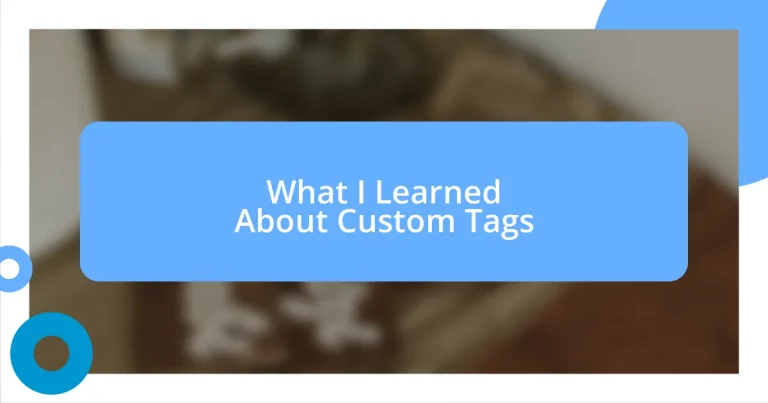Key takeaways:
- Custom tags enhance organization, collaboration, and personalized workflow by allowing users to categorize and streamline their tasks effectively.
- Best practices for creating custom tags include keeping them simple, ensuring consistency, and regularly reviewing their effectiveness to align with evolving projects.
- Future trends in custom tagging include the use of automation and AI for tag generation, increased personalization for audience engagement, and improved integration across platforms for cohesive workflows.

What are custom tags
Custom tags are specialized labels that you can create to organize, categorize, or enhance content in a way that makes sense for your unique needs. I remember the first time I implemented custom tags in my project management tool—I felt a wave of relief because everything suddenly became more organized. The flexibility they offer is truly empowering; you can group related tasks or projects to better visualize your workflow.
What fascinates me is the sheer creativity involved in developing custom tags. It’s not just about functionality; it’s also about how these tags reflect your personality and workflow style. Have you ever felt overwhelmed with a cluttered interface? Custom tags can transform that chaos into a streamlined process tailored to your preferences.
To me, custom tags represent an opportunity for personalized efficiency. They can enhance collaboration by allowing team members to quickly identify and locate relevant information. I often find that the right tag can be a game-changer during discussions, as it ties everything back to a central theme or objective, making communication clearer and more effective.

Benefits of using custom tags
Using custom tags can significantly streamline your workflow by providing clarity and a sense of order. I remember a time when I was juggling multiple projects, and my typical tagging system just wasn’t cutting it. Once I started using custom tags tailored to my unique projects, it felt like I had suddenly unlocked a hidden feature of productivity. Everything was categorized in a way that made sense to me, and because of it, I could focus more on the work itself rather than searching for scattered information.
Here are some specific benefits of using custom tags:
– Improved Organization: Custom tags help in sorting through tasks or documents much faster.
– Enhanced Collaboration: Team members can identify and access relevant information effortlessly, fostering better communication.
– Personalized Workflow: Tailoring tags allows you to create a system that reflects your own style and needs, making the process more enjoyable.
– Clear Focus: I often find that using precise tags keeps me centered on the main objectives of my tasks, reducing the risk of getting lost in the details.
– Flexibility: As projects evolve, custom tags can be adjusted, ensuring they remain relevant and valuable over time.

How to create custom tags
Creating custom tags is an enjoyable and rewarding experience. For instance, when I first designed tags for my personal blog, I was amazed at how simple adjustments could reflect my evolving themes. Start by identifying what aspects of your content or tasks need tagging—consider your objectives. It’s essential to keep your tags clear and meaningful; after all, the point is to enhance clarity, not complicate things.
One effective approach is to brainstorm potential categories with your team or colleagues. I once facilitated a session where we collectively crafted tags for an upcoming project, and the creative energy was palpable. Collaborating in this way not only produced a diverse array of tags but also fostered a sense of ownership and engagement among the team. The comprehensive discussions that followed helped us ensure that the tags accurately encapsulated our varied workflows.
As you think about implementing custom tags, remember to test and refine what you create. In my own experience, I’ve revisited tags after a few weeks to see if they still serve me as intended. I discovered that regularly updating my tags led to a more intuitive organization system that evolved organically with my projects. Ultimately, your custom tags should feel like an extension of your thought process.
| Custom Tag Feature | Description |
|---|---|
| Identifying Purpose | Determine the key areas that need tagging based on your unique workflow. |
| Collaborative Creation | Engage with team members to brainstorm tag ideas that reflect collective goals. |
| Regular Review | Periodically reassess and update tags to ensure they remain relevant and effective. |

Best practices for custom tags
When it comes to creating custom tags, one of the best practices I’ve discovered is to keep them simple and descriptive. I remember the first time I went overboard with tags—I ended up with a confusing jumble that made finding what I needed a real headache. Have you ever felt overwhelmed by cluttered tags? I found that aiming for clarity not only saves time but also reduces frustration. Simplicity in tagging allows both you and your team to quickly recognize categories, making work flow much smoother.
Another effective strategy is to ensure consistency in your tagging system. When my colleagues and I agreed on a standardized format for our tags, it was like a light bulb went off. Suddenly, no matter who was updating the project, everyone understood exactly what each tag meant. I can’t stress enough how consistency enhances communication and collaboration. Isn’t it reassuring to know that you can rely on a shared understanding? This practice elevates your entire workflow, making it seamless.
Finally, I highly recommend regularly revisiting and refining your custom tags. I often carve out a few moments during my week to reassess their effectiveness. Recently, I found that some tags I created were too niche and didn’t resonate as I initially thought. By cleaning up and adjusting those tags, I regained a sense of order and efficiency. Have you tried this method? Trust me, a little tweaking goes a long way in keeping your tagging system relevant and aligned with your evolving projects.

Common pitfalls to avoid
A common pitfall I’ve encountered is overcomplicating tags. Early in my tagging journey, I once ended up with a dozen variations of similar tags, like “Social Media Post,” “Social Media Content,” and “Social Media Release.” It became a headache to remember which tag to use! Have you ever had that overwhelming feeling? By simplifying my tagging strategy and sticking to fewer, well-defined categories, I experienced a noticeable boost in organization and efficiency.
Another trap to avoid is neglecting the importance of team communication surrounding tags. I recall a project where my teammate and I developed tags independently without discussing them. When it came time to organize our work, we were speaking different tag languages! This misalignment created confusion and ultimately slowed our progress. By ensuring everyone is on the same page with tagging conventions, you can prevent such misunderstandings and promote a culture of collaboration.
Finally, I find that failing to integrate user feedback into your tagging process is a major setback. After rolling out my initial set of tags, I discovered that the way I viewed my content didn’t align with how others perceived it. This realization hit hard. How could I have missed that? By opening up the conversation and seeking input from both colleagues and end-users, I learned the importance of evolving my tags so they better meet the needs of everyone involved. Engaging with others not only leads to better tagging systems but also fosters a stronger sense of community within your team.

Examples of effective custom tags
When I think about effective custom tags, one particular experience stands out. I once implemented a tagging system for a marketing campaign that utilized tags like “Q1 Strategies” and “Target Audience Insights.” These descriptive tags transformed chaos into clarity, enabling our team to quickly locate and discuss specific elements of the project. Have you ever had that moment when everything just clicks into place? It’s truly empowering.
Another striking example revolves around a time I experimented with color-coded tags in a project management tool. I created vibrant tags like “Urgent,” “In Progress,” and “Completed,” which not only added visual appeal but also enhanced our workflow. I can still feel the relief of knowing what needed immediate attention at a glance! Isn’t it fascinating how something as simple as color can facilitate communication in such a dynamic way?
Moreover, I’ve found that leveraging tags for feedback has proven exceptionally beneficial. For instance, during a recent content review, I introduced tags like “Needs Edits” and “Approved for Publication.” This allowed my team to effortlessly categorize content based on its status and facilitated smoother collaboration. Reflecting on this, I realized how effective communication through tagging can spark deeper conversations. What strategies have you used that sparked unexpected insights? It’s amazing how well-chosen tags can elevate not just organization but also foster an open dialogue in any project.

Future trends in custom tags
As I look ahead to the future of custom tags, I can’t help but get excited about the potential of automation and artificial intelligence. Imagine walking into a project where tags are generated based on the content’s context and usage patterns without any manual input! I once participated in a workshop where we discussed the power of AI, and it struck me how these advanced tools could recognize themes and streamline tagging systems. How liberating would that be?
Another trend I see is the emphasis on personalization in tagging. I remember a time when I curated tags specifically tailored to my audience’s interests and behaviors. This targeted approach resulted in a remarkable increase in user engagement. I wonder, how well are we currently serving our audience’s needs through our tagging systems? As platforms evolve, so too will the necessity for tags that resonate more deeply with individual users.
Lastly, the increasing integration of tags across various platforms will shape how we interact with content. Not long ago, I collaborated on a cross-platform initiative, and I experienced firsthand the challenges of maintaining consistency in tagging. But this future connectivity offers a thrilling opportunity to create cohesive ecosystems. Can you envision a scenario where tags effortlessly travel across tools and systems, enhancing our overall workflow? The possibilities feel endless, and it excites me to think about what effective tagging will look like in years to come.














